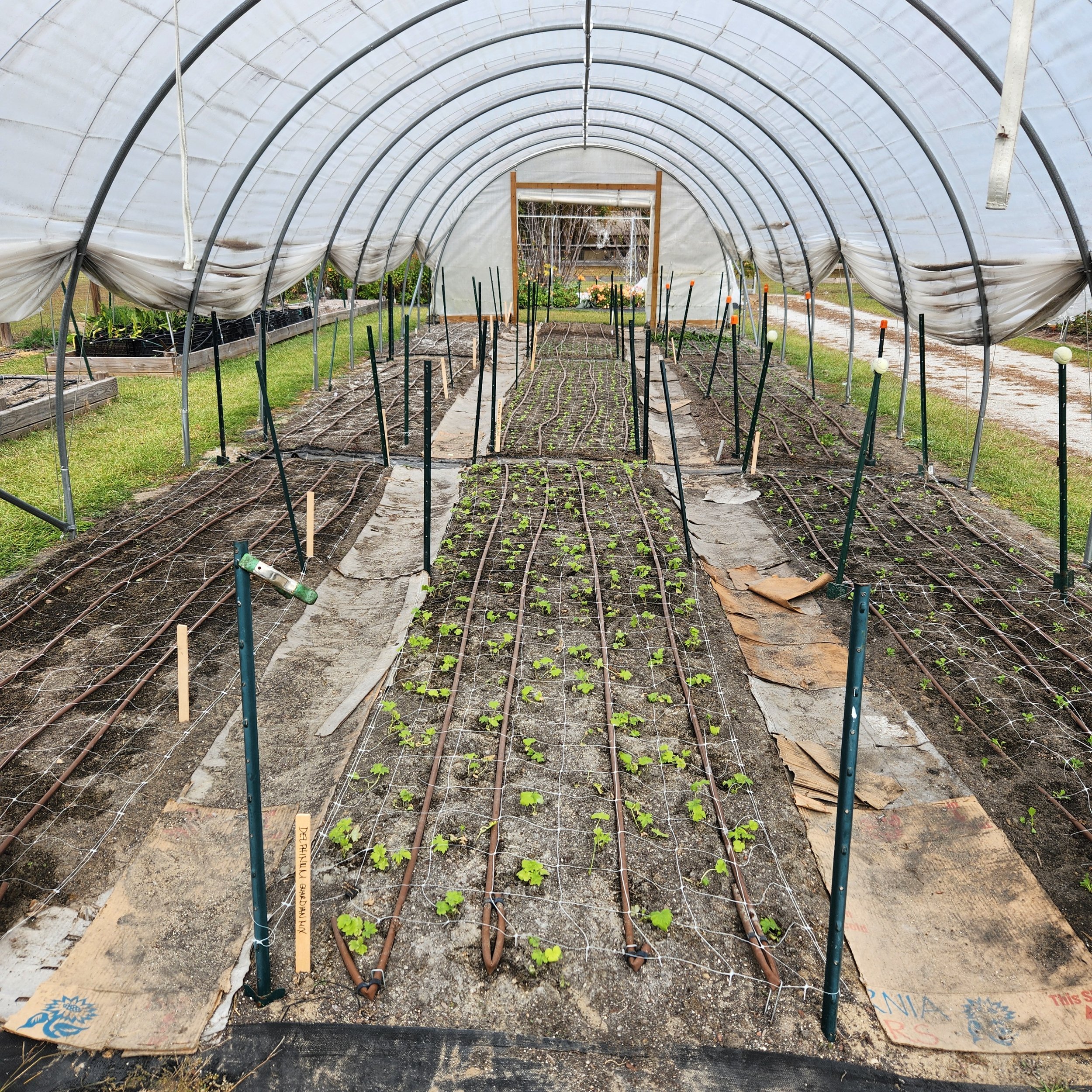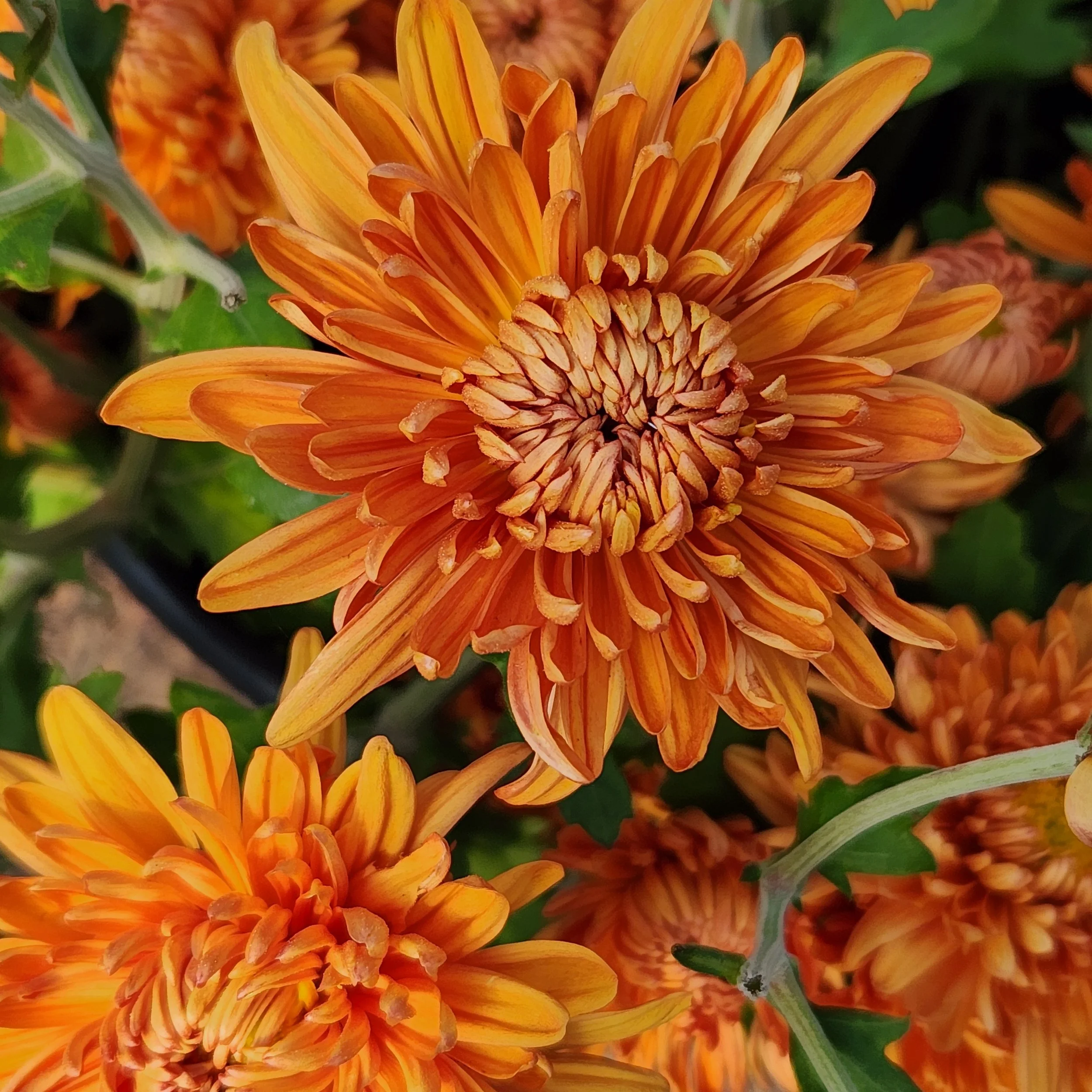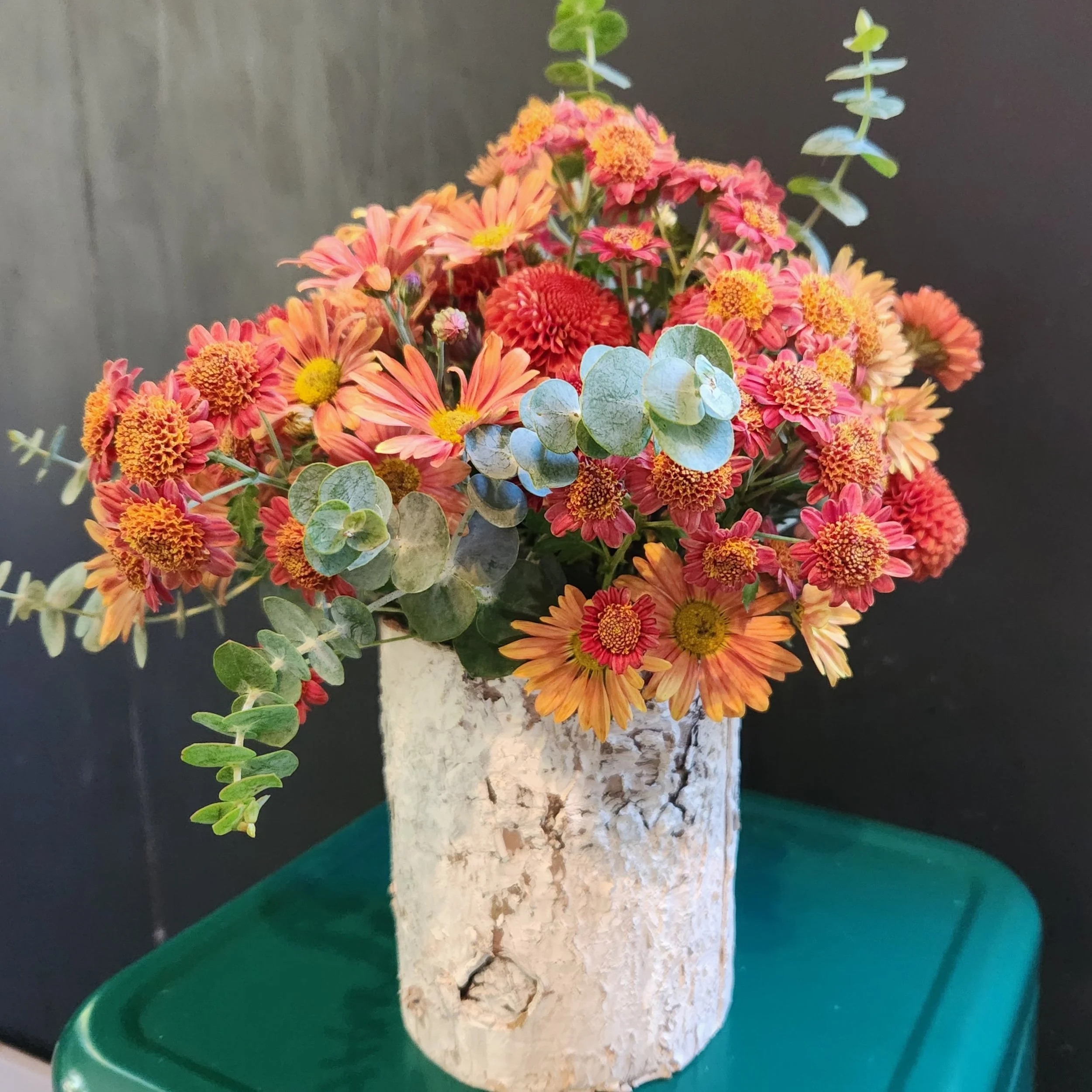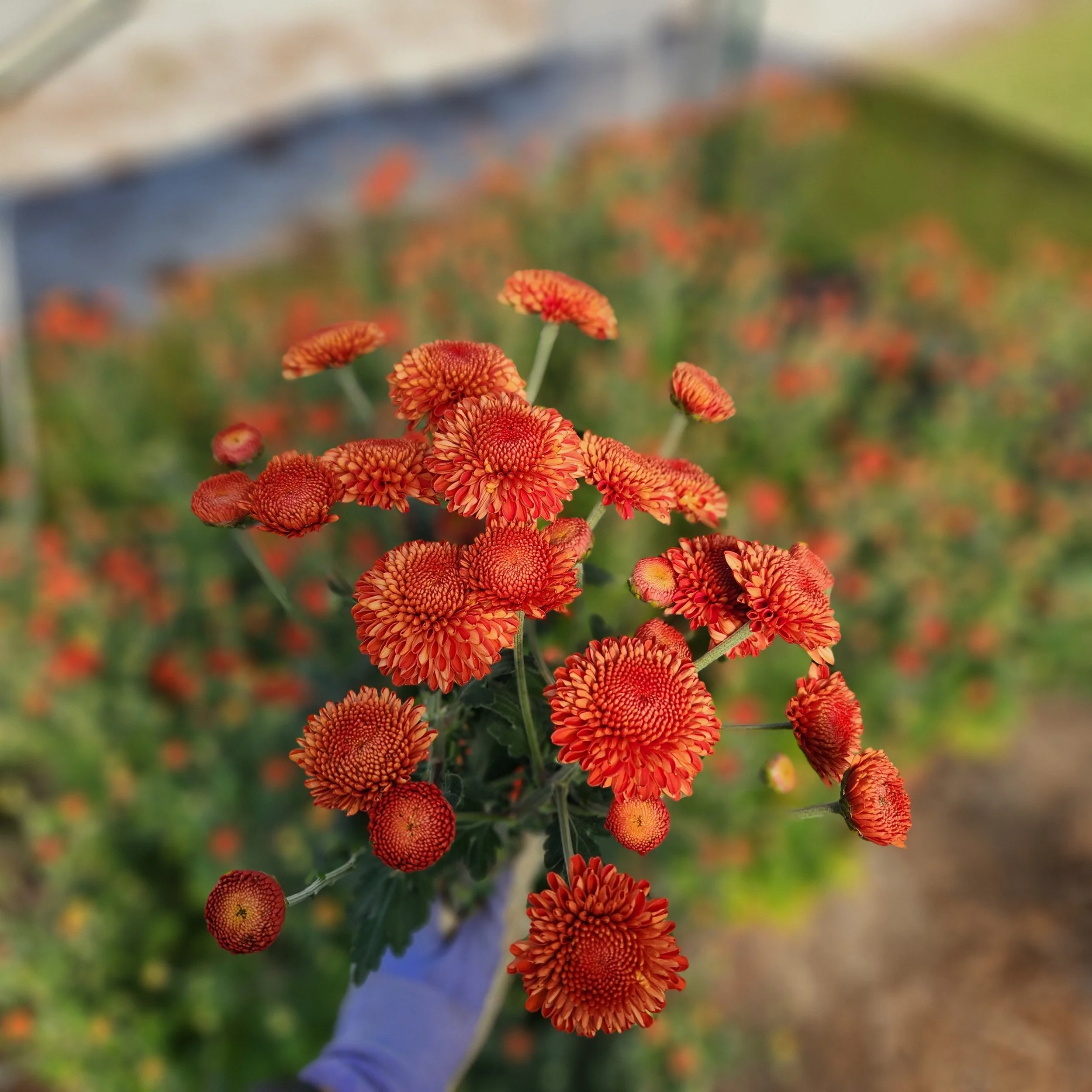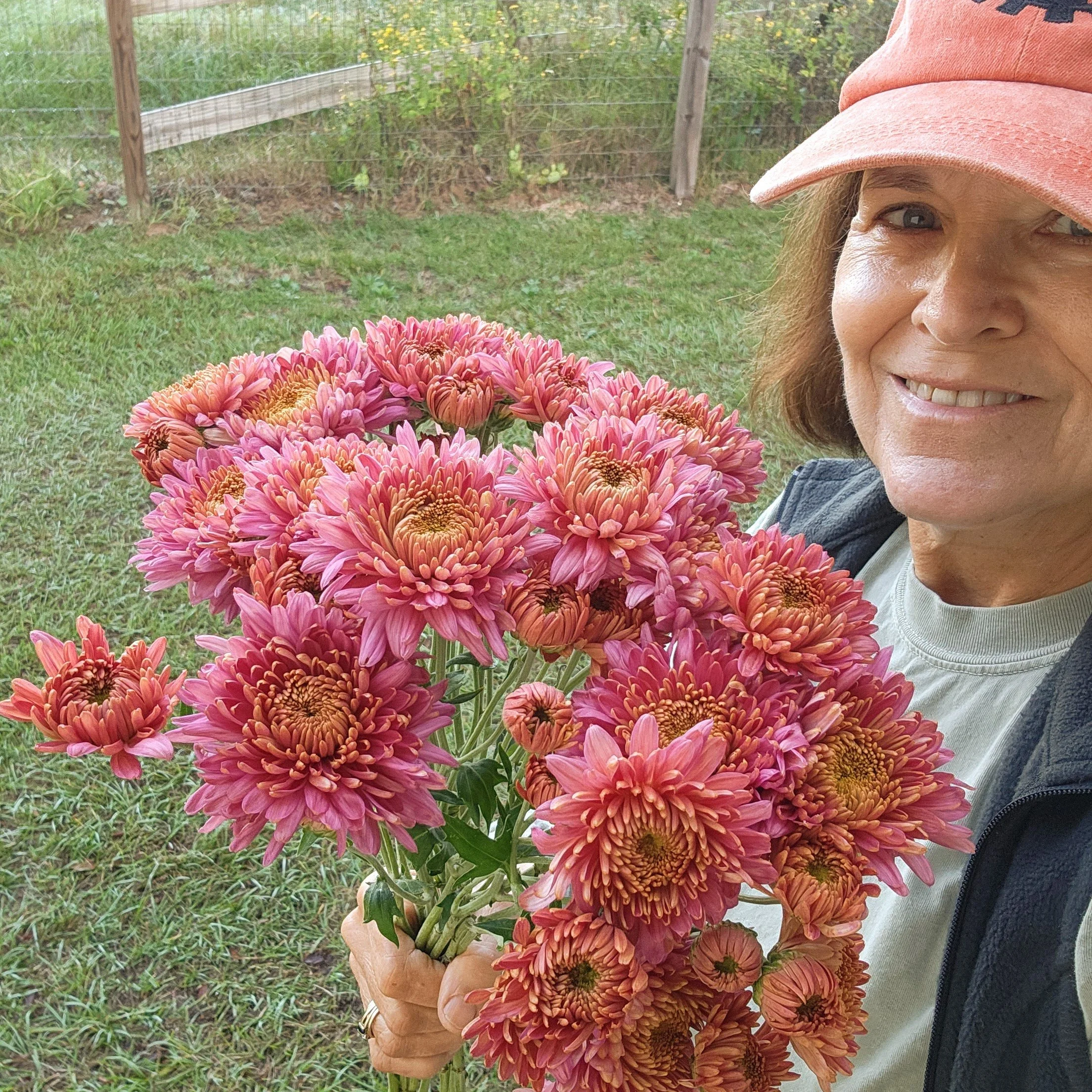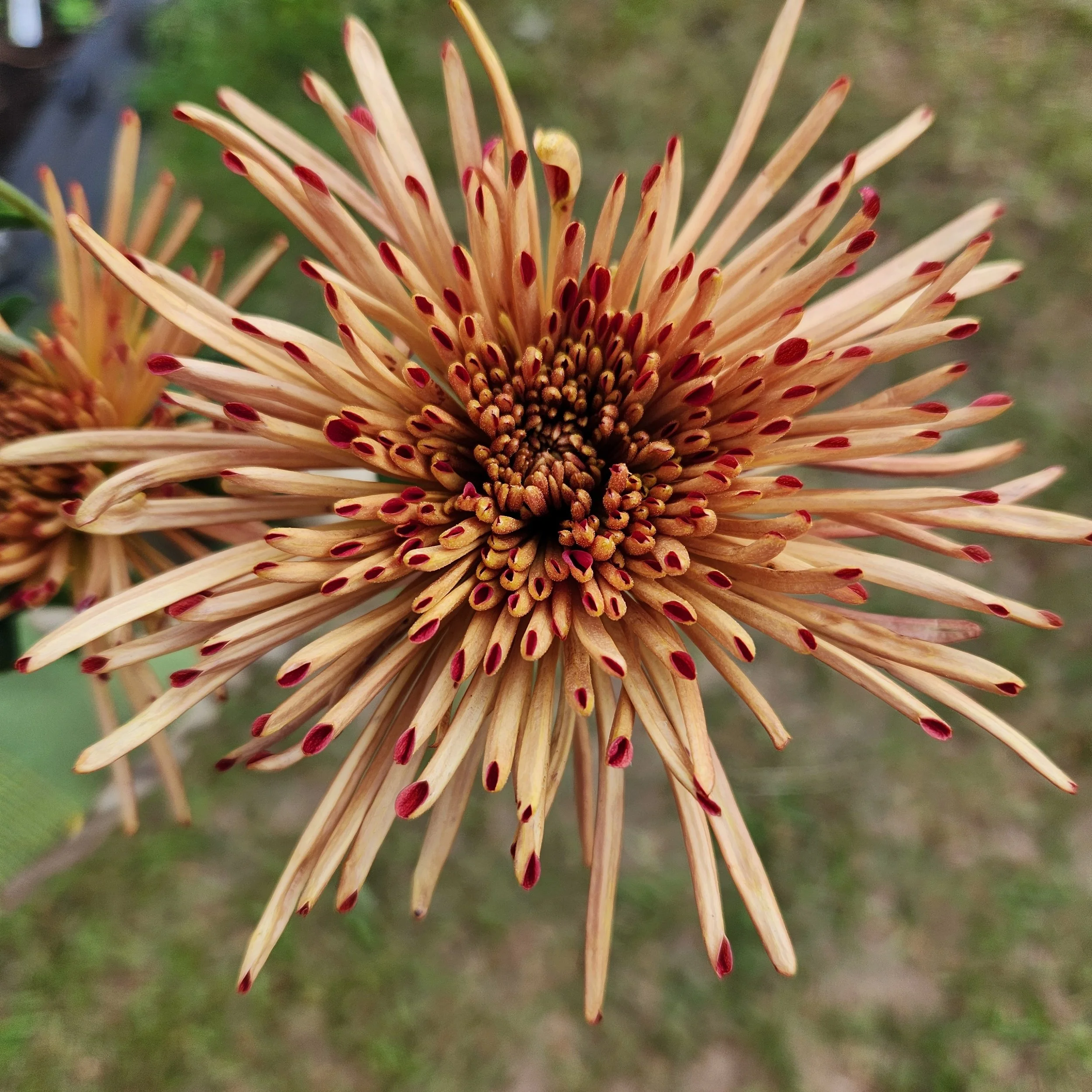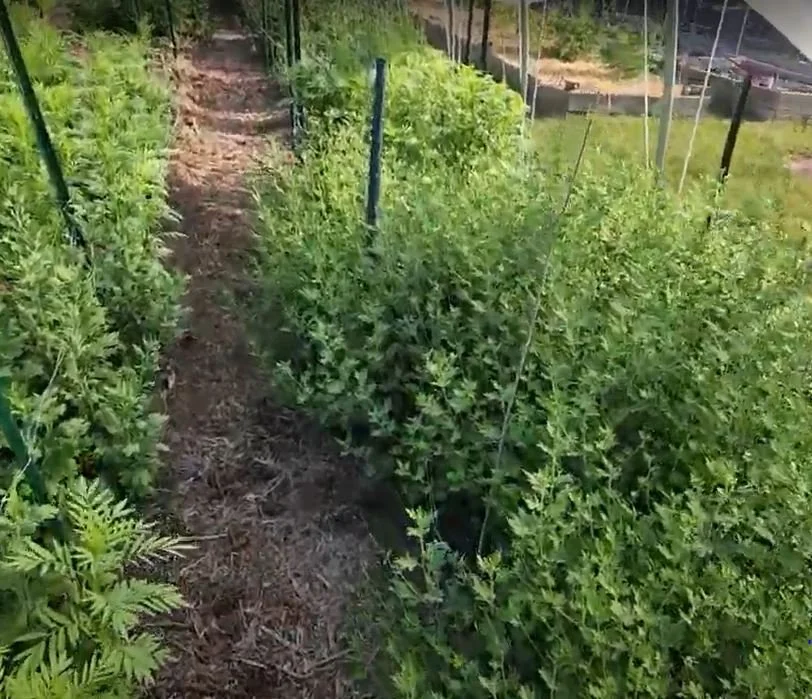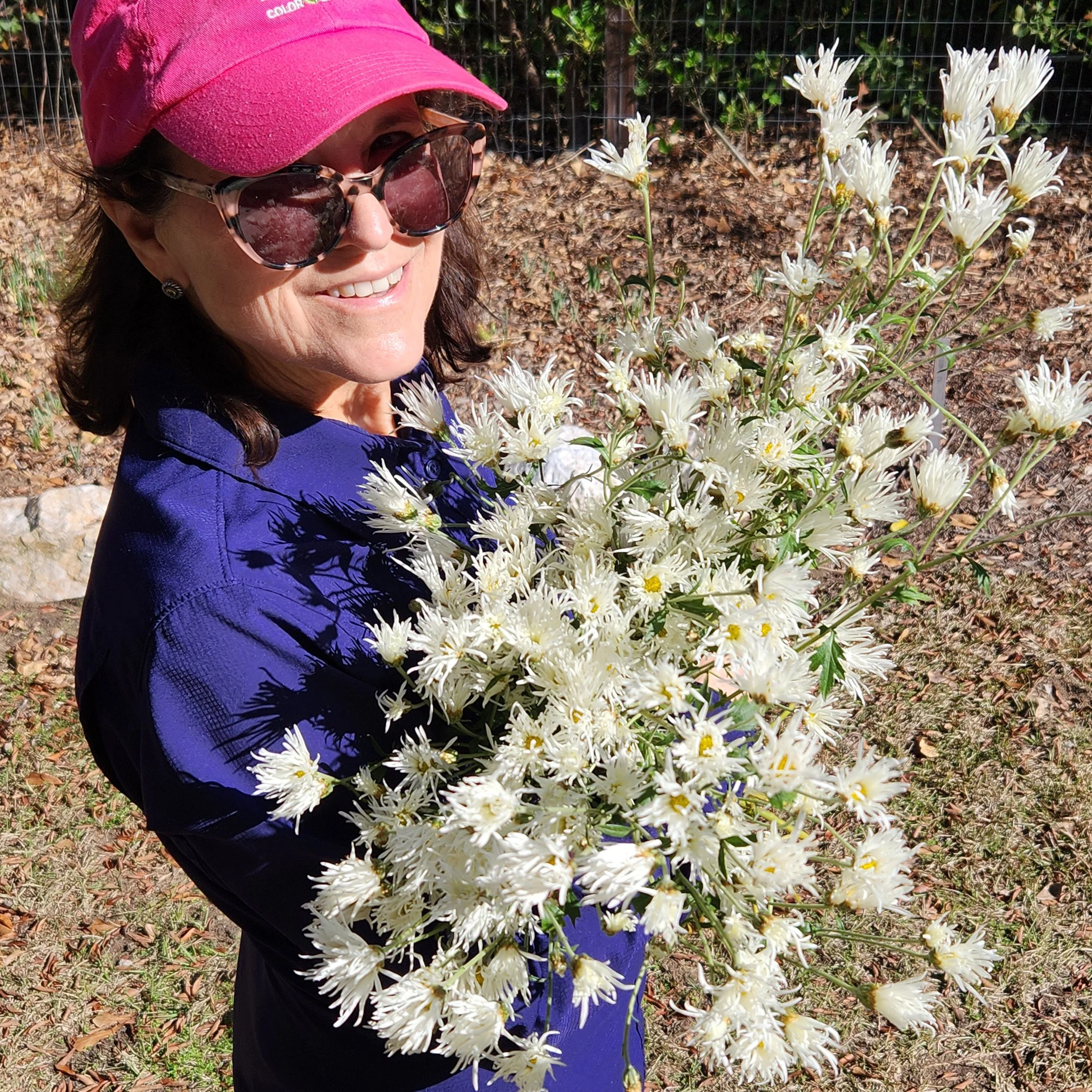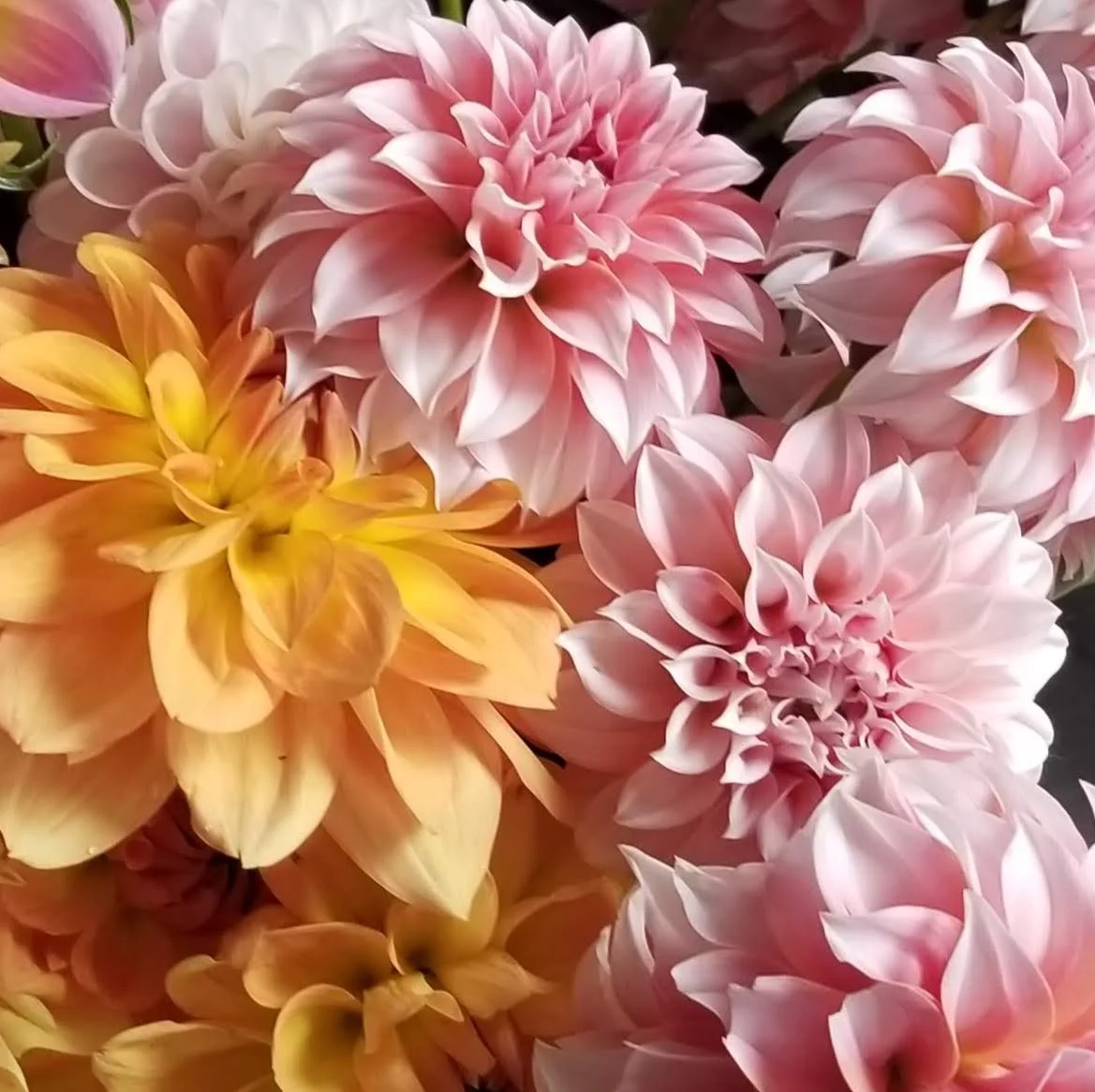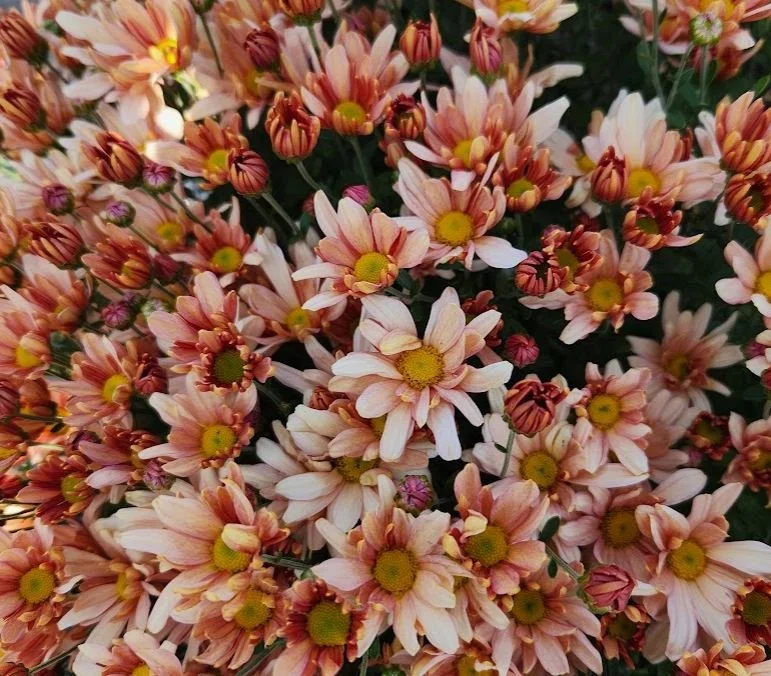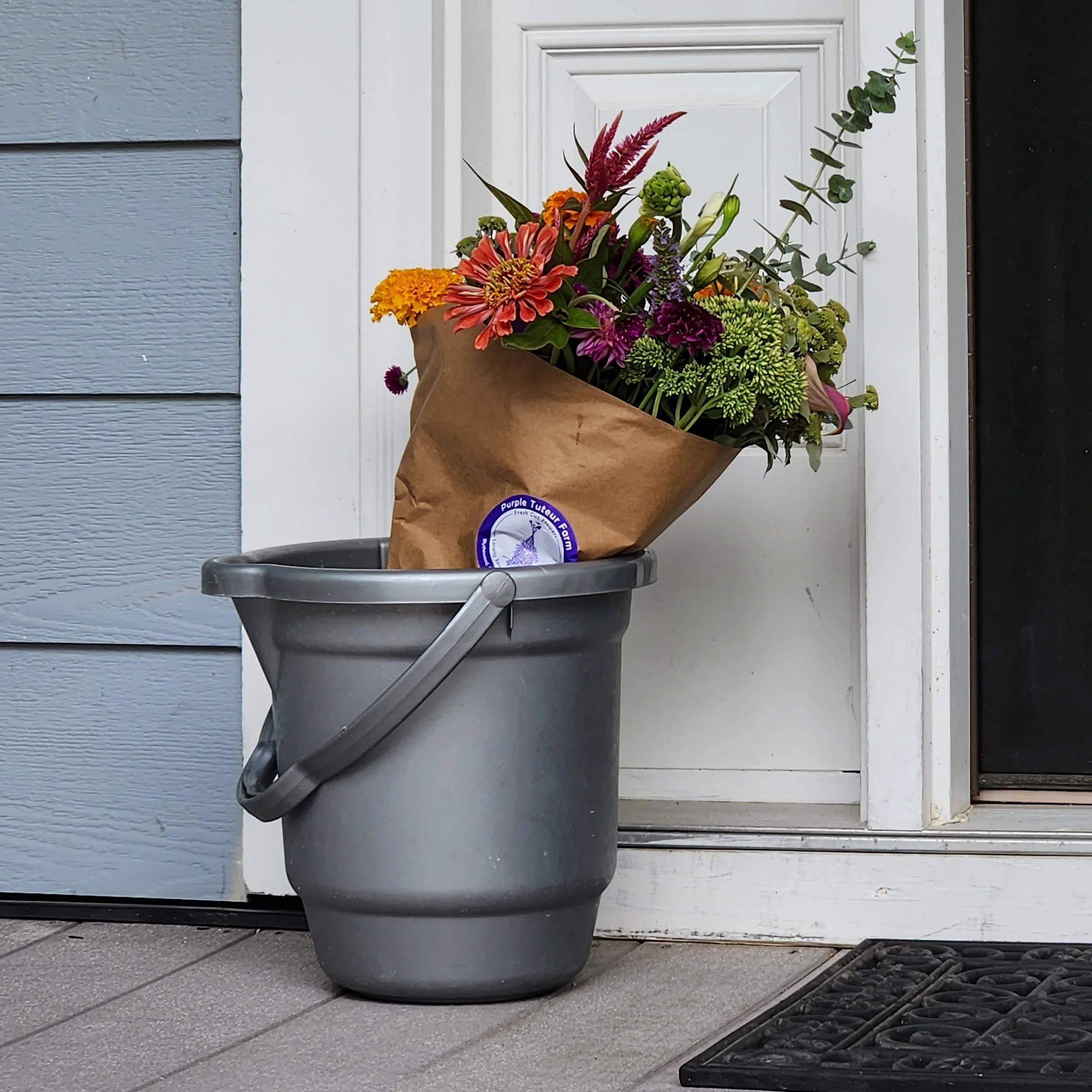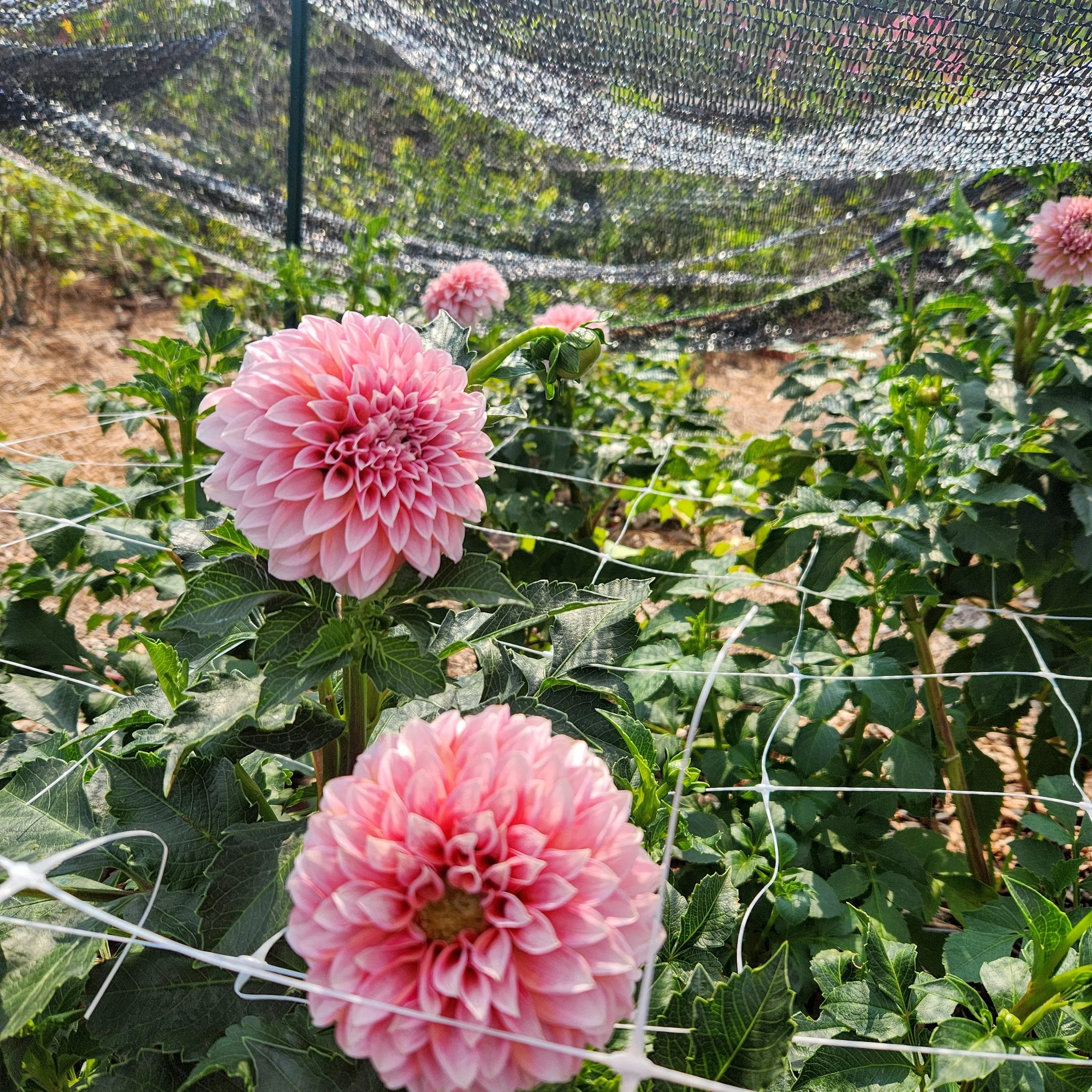December at the Farm: Preparing for a New Flower Year
Even though the days are short, there’s a surprising amount happening on the farm right now. We’ve direct-sown a lot of seed for our Early Spring Subscriptions, and everything is tucked under frost cloth to protect it during those below-freezing nights. This includes cool-season favorites like nigella, larkspur, anemone, and orlaya.
Direct Seeded Beds
Cress waiting to be thinned
This week we checked germination (thank you, rain—you delivered!) and raised the covers with hoops so the wet cloth isn’t resting on the seedlings during freezes. If the cloth touches the plants, they lose their insulation and can freeze—one of those small winter details that makes all the difference.
Inside the Hoophouse
Poppies (lower part of the bed, not blooming) and pansies (mostly blooming) in the hoop house
Inside the hoop house, things look especially cheerful: ranunculus, canterbury bells, delphinium, snapdragons, poppies, and pansies. Everything is covered except the poppies and pansies, and I appreciate both of these crops in winter because I can see them without lifting fabric.
Poppies hail from Iceland, so a brush with freezing temperatures doesn’t bother them. We grow them in the hoop house so that once the blooms begin, the petals stay pristine. As temperatures rise in late winter, we switch to shade cloth to help keep them cool.
And then there are the pansies and violas—my absolute favorite winter crop. They bloom quickly, keep blooming all winter long, and bring so much joy to the hoop house during the quieter months. We deadhead them regularly so they don’t go to seed. They stay fairly short until the days reach 12 hours of light; then they gradually elongate, and by May they’re long enough to use in bouquets.
We start some pansies from seed and also buy some as small plants called plugs. Not all pansy varieties stretch tall enough for cutting—most breeding has focused on short bedding plants. There are seed varieties that elongate well, and hopefully in time we’ll see those available as plugs from local nurseries. If you’d like to dig deeper, I highly recommend Pansies by flower farmer and author Brenna Estrada; her variety trials are incredibly helpful for anyone wanting to grow pansies for floral design.
More Winter Work
Weeding e.g. removing the henbit (red x) so that the larkspur can grow.
Over the next couple of weeks, we’ll be weeding and preparing additional beds for early spring planting. Winter is also when we handle the repairs that get pushed aside during the busy season—mending raised beds, fixing infrastructure, and taking care of the small-but-important tasks that keep the farm running smoothly.
We’ll also be digging and dividing our dahlias and getting them ready for next season. We’ll have some available for sale in the spring, and they’re always a popular choice for gardeners eager to grow their own blooms.
Holiday Blooms
If you still need a last-minute amaryllis or some paperwhites, please check the website. We have a few left, along with bundles of greens to help “deck the halls.” Thank you to everyone who has purchased bulbs this year—your support helps us keep our team on payroll through the winter months, when so much of the behind-the-scenes work is happening quietly and won’t really show itself until spring.
We are there on Thursday this week and Monday and Thursday of next week for pick up . We can deliver on Friday this week and Tuesday next week. After that we will be doing our own holiday preparations!
Got Plans Saturday Morning?
Starting the countdown to Christmas? Whether this email finds you pulling on a raincoat, clutching your coffee, or hiding under a blanket pretending December isn’t real… I hope you’re doing well. Truly.
We’re here to make this season a little lighter and a little brighter. We take care of some of the planning and prep so you can focus on what matters — and yes, helping you experience the joy of flowers all year long absolutely includes the holidays.
Right now, we’ve got amaryllis and paperwhites at every stage of the growing journey. Want dormant bulbs to pot up yourself? Perfect for enjoying in the stillness of January when the world finally exhales again. We still have Minerva and Bolero amaryllis bulbs available, plus the kind of paperwhites that make you smile the moment they open.
Prefer something already started? We’ve got amaryllis and paperwhites growing in nursery pots — easy to repot into your own favorite containers if you want a custom holiday showstopper.
Need a gift? We’ve got that covered too. Choose from decorative potted paperwhites and amaryllis or our bulb garden kits (just add water to start the magic). These are incredibly simple, thoughtful gifts that feel special without adding to anyone’s holiday stress.
Everything is available on the website for order, pickup and delivery and we’ll be open at the farm this Saturday from 10–noon. Come by, grab a cup of coffee, browse the bulbs, and if you want help potting something up, we’re happy to jump in. Make a purchase, hang out for a bit — it’s all good. We love meeting our friends and followers in person, so don’t be shy. Come on out.
Here’s to a happy holiday season,
Linda
P.S. If you are a Richland County Master Gardener planning to attend the holiday luncheon next week, and you would like me to bring your order to the meeting, I’m happy to deliver them there. Just select pick up at check out and add a comment at check out to deliver them to the MG Holiday luncheon and I will have them there!
2026 Flower Subscriptions Are Now Open!
We’re excited to announce that our 2026 bouquet subscriptions are officially live on the website! If fresh, local flowers delivered to your doorstep are your kind of happiness, now’s the time to secure your spot.
We’ve brought back all three seasonal subscriptions — and added the All Seasons Membership as a new option.
Here’s a quick look at what’s available:
✨ NEW for 2026: The All Seasons Bouquet Subscription
Three seasons of beauty — in one subscription.
Get 12 or 24 bouquets, including:
Early Spring (Mar–Apr)
Spring to Summer (May–Jun)
Late Summer to Fall (Aug–Oct)
All delivered on our natural farm schedule, including the built-in July–mid August summer pause.
Weekly (24 bouquets): $1080
Biweekly (12 bouquets): $540
Delivery included. Choose Tuesday or Friday
🌱 Early Spring Subscription (Mar–Apr)
The first blooms of the year: tulips, ranunculus, anemone, hellebores, and more.
From $189 • Weekly or biweekly • Choose Tuesday or Friday
🌸 Spring to Summer Subscription (May–Jun)
Peak-season color and variety — lisianthus, zinnias, lilies, early dahlias, sunflowers.
From $189 • Weekly or biweekly
🍂 Late Summer to Fall Subscription (Aug 18–Oct 20)
Dahlias, heirloom mums, warm fall textures, and all the moody magic of autumn.
From $189 • Weekly or biweekly
(No deliveries September 8, 2026)
Delivery Areas
29201, 29204, 29205, 29206, 29209, 29016, 29045, 29169, 29223, 29229
Why Subscribe?
Guaranteed blooms during the best weeks of each season
Priority access to our most limited flowers
Convenience — we grow, harvest, design, and deliver
Freshness you simply won’t find in stores
A stunning weekly (or biweekly) pick-me-up
Plus, subscriptions make unforgettable gifts — especially holiday, birthday, and “just because” surprises.
From Our Farm to Your Home
Thank you for supporting our little farm and for giving us the joy of growing for you. These subscriptions are the heartbeat of our season — they allow us to plan, plant, and create with intention.
👉 If you’re ready to bring a year of flowers into your home, our 2026 subscriptions are now open. You can browse all options on the website.
Here’s to a year ahead filled with color, beauty, and moments that make you stop and take a deep breath.
With gratitude,
Linda Bradley
Purple Tuteur Farm
A Little Pause Before the Holiday Rush
This week, we’re hitting the pause button—in the best way possible. We’re taking a bit of time to step away from the daily farm work, share meals with friends and family, and catch our breath before the holiday season kicks into high gear. Consider it that quiet moment before the orchestra swells.
Of course, “time off” on a flower farm still involves plenty of plant mischief. Our spring hoop house is officially planted, and everything inside is settling in for its winter nap so it can burst into color next spring. It’s always a thrill to look down those tidy rows and think, this is where next season begins.
Future ranunculus, campanula, delphinium, poppies, pansies and snapdragons are planted here.
Holiday Bulbs Are Here
If you’ve been waiting to bring a little magic indoors, your moment has arrived:
Our amaryllis and paperwhite bulbs are now available.
These are the big, beautiful bulbs we’re known for—easy to grow, reliably showy, and perfect for gifting or brightening your own home. We’ve also potted some up for you, and starting the week after Thanksgiving, we’ll have pre-planted bulb gardens posted to the website. Just bring them home, give them a little water, and watch the magic unfold.
Next Delivery Date: November 25
If you're planning ahead, our next delivery date is 11/25—perfect timing for holiday decorating or sending a thoughtful surprise to someone who needs a little brightness this season.
Looking Ahead to 2026
And because we know some of you like to plan several seasons ahead (our kind of people), we’ll also be opening 2026 subscription orders in early December. It’s always exciting to see next year’s subscriptions start filling up—your support helps us plan what and how much to grow, and it keeps this little farm humming.
If you need a moment of calm, joy, or beauty this week, we’ve got you. Happy almost-holiday season—may your week include rest, warmth, and something that makes you smile.
A few more mums!
And in the spirit of the season, thank you. We’re endlessly grateful for the love, enthusiasm, and support you’ve shown our little farm. Every message, every visit, every bouquet on your kitchen table—it all matters more than you know.
Here’s to rest, good company, and the beauty still ahead.
Linda
Another Burst of Fall Color
Just when we think the mum season can’t get any prettier, these late bloomers step up and prove us wrong. The field is glowing right now with coral, apricot, and sunset shades that seem to hold onto autumn’s light just a little longer. These heirloom mums have been a joy to grow and even more fun to share. Their long stems and sturdy blooms make them perfect for arranging, and they last beautifully in the vase. This week’s favorites:
Annie Girl
Coral Reef
Daybreak
Apricot Alexis
River City
💐 Fresh 8–10 stem bunches are available for $25, farm pick-up only:
Wednesday, November 12 • 10 a.m. – noon
Monday, November 24 • 10 a.m. – noon
If you’ve been waiting to experience these mums up close, this is your moment — before the season wraps up and we turn our attention to holiday bulbs.
✨ Come by the farm, pick your favorite colors, and take home a little piece of the fall show.
Thank you for following along with our mum journey this year and celebrating the joy these heirloom flowers bring.
Linda
From Mums to Magic Bulbs: November at the Farm
The mums are still putting on a beautiful show here at the farm, and we’re savoring every last bloom. Each variety seems to shine in its own moment—soft apricots, rich bronzes, and warm pinks lighting up the beds. If you made it out to our open house this past weekend, thank you! It was such a joy to share this season’s blooms with you in person.
And we have a winner from our Thanksgiving mum arrangement giveaway — congratulations to Evelyn Abernathy! Your birch-bark vase of farm-grown mums will be ready for you soon.
If you would like one of these arrangements, they are available for pre-order on our website now. Each arrangement is handcrafted and one of a kind, perfect for adding natural beauty to your holiday table, buffet, or entryway.
As we move from fall flowers into the cozy glow of the holidays, our attention turns to something new in the shop: amaryllis and paperwhite bulbs. These easy-to-grow favorites bring beauty indoors just when we need it most.
We’ve sourced truly exceptional jumbo amaryllis bulbs — the biggest you’ll find anywhere — and top-grade paperwhite bulbs for simple winter blooming. Whether you want to plant your own, send a thoughtful gift, or start a ready-to-grow bulb garden, these are perfect for bringing natural joy into your home this season.
Bulbs are available now in the online shop, with complete kits and gift pots coming soon as we have just started them here at the farm. They’re a wonderful way to bridge the seasons — from the last mums of fall to the first blooms of winter.
Experience the Joy,
— Linda and the whole Purple Tuteur team
Mum Season Continues to Delight
Round Two of Mum Blooms
For me as a grower, it’s a bit like Christmas at the farm right now. The mums are truly taking center stage as the weather cools, and each week brings a few new blooms to discover.
Since our last update, several new varieties have opened — Fall Affair, Campfire Glow, Peter Mangus, Kelvin Mandarin, Savanna Charlton and Bronze Fleece — each one adding its own personality to the season’s palette.
Fall Affair
Campfire Glow
Peter Mangus
Kelvin Mandarin
Savanna Charlton
Bronze Fleece
We also wrapped up the final step on the hoop house by getting the end walls covered (yay!) — just in time for the cold weather ahead. I am so grateful to my husband Rufus (a.k.a. Mr. Fix It for doing this project with me.
While many mum plants are hardy perennials, their flowers are not. Anything currently blooming when frost hits needs protection if you want to enjoy the flowers in the garden a bit longer. This is why we needed the hoop house.
Farewell to the Dahlias
We’re saying goodbye to the dahlias this week. With rain and cold moving in, their days are numbered — but what a beautiful season they’ve had!
We’re so grateful that you’ve loved our dahlias as much as we do. It’s always bittersweet to see them go, but the mums are making the transition a little easier this year.
Looking Ahead: Anemone & Ranunculus Bulbs
Our Fall Bulb Sale continues through Halloween! Skip the tricks and treat yourself to early-spring joy with anemone and ranunculus bulbs. Each order includes growing instructions to help you succeed. Check out the selection here.
A heartfelt thank-you to everyone who has already ordered — your future self (and your spring garden) will thank you! 🌸
Come See the Mums!
Would you like to experience the mums in person? We’re considering a casual open-farm visit next Saturday, November 1 from 11 a.m. to 2 p.m. to celebrate this beautiful season.
If you’d be interested in coming, please let us know by replying to this email — we’d love to have you visit and see these stunning blooms up close. Of course, we will have bouquets available for purchase so that you can take some of this beauty home.
Every season on the farm has its own kind of magic, and we’re so grateful to share it with you. Whether you’re growing, arranging, or simply enjoying flowers on your table — thank you for being part of our story.
Linda
The Mum Season Has Started!
This time last year, The Mum Project was just an idea — a hope to bring back the beauty of heirloom chrysanthemums to our corner of South Carolina. We’d seen the incredible work of other local flower farms reviving these lost varieties and knew we wanted to be part of it.
With the help of the ACRE grant, that vision took shape. In early spring, we began construction on our new hoop house, designed specifically to extend our growing season and give these mums the conditions they love best — cool nights, steady moisture, and protection from our unpredictable fall weather.
Next came the growing beds — carefully built, amended, and mapped for 18 varieties of heirloom mum varieties passed down through dedicated chrysanthemum societies and small farms. These aren’t your typical potted mums. They’re true heirlooms — varieties once treasured for their elegance, fragrance, and sculptural petals, now making a comeback thanks to local flower growers.
The 18 varieties we selected are divided into 6 varieties each from the early, mid-season and late-season categories. These classifications are assigned by the National Chrysanthemum Society. We do this so we don’t have the entire hoop house blooming at the same time.
Over the next few weeks, we’ll be sharing photos and stories as each variety comes into bloom. It’s been a journey of learning, growth, and joy — and we can’t wait for you to see what’s next.
Here are the first three:
Fall Charm
Peach Centerpiece
Pumpkin Eyes
Thank you for following along, for cheering us on through every stage of this project, and for believing in the power of local flowers. Send us your questions, and we will do our best to answer them in the coming updates.
Happy Fall,
Linda
The Fall Bulb Shop Is Open!
The wait is over—the bulbs have arrived, and our Fall Bulb Shop is officially open!
We’re surrounded by boxes of beautiful ranunculus and anemone corms. These are the flowers that chase away winter gray and remind us that beauty is always just below the surface, waiting for the right moment to shine.
Whether you’re a seasoned gardener or just beginning to explore the joy of growing your own flowers, these specialty bulbs are a wonderful place to start. We’ve selected our favorite varieties for both garden performance and vase life—rich jewel tones, delicate pastels, and everything in between.
This year’s shop also includes a few extras we think you’ll love:
🧤 Atlas Gardening Gloves – our favorite lightweight, breathable gloves for every task in the garden.
📘 Compost Tea eBook – a simple, practical guide to improving your soil health naturally, using the same methods we rely on here at Purple Tuteur Farm. Available as a digital download.
The Fall Bulb Shop will be open through October, and all orders will be shipped by November 3. Pickup and delivery options are also available, and active subscription members can even add bulbs to their next bouquet delivery.
🌾 A Taste of the Farm – Late Fall Subscriptions
If you’ve been missing fresh blooms on your table, our Late Fall Subscription – A Taste of the Farm is the perfect way to close the season. These limited three-week subscriptions feature the best of our heirloom chrysanthemums and late dahlias, hand-harvested and delivered through October. It’s a lovely way to enjoy the last colors of the field before winter’s rest. Order 1,2 or 3 weeks of blooms by October 13.
👉 Reserve Your Late Fall Subscription
There’s so much beauty still to come this season, and we’re grateful to share it with you. Whether you’re planting bulbs, enjoying the last of the field flowers, or planning ahead for holiday blooms—thank you for being part of our flower-loving community.
Experience the joy,
Linda
Purple Tuteur Farm
P.S. Holiday bulbs (like amaryllis + paperwhites) are coming soon—stay tuned for details in early November!
A Beautiful Finale: Late Season Bouquets & Our New Hoop House
Oberlin
As the days shorten and the air turns crisp, many people think the flower season has ended. But here at Purple Tuteur Farm, we’re just getting started on one of the most beautiful parts of the year. Thanks to our heirloom chrysanthemums and our brand-new hoop house, we’re able to extend the season and bring you fresh, abundant bouquets all the way through October and possibly into November too.
The Magic of Heirloom Mums
Fall Charm
Heirloom mums have a very long history but were almost lost as they were replaced in the marketplace by uniform, short-lived potted mums. For decades, chrysanthemum societies across the country quietly worked to keep these now-rare varieties alive. Today, local flower farms are bringing them back to the market—and customers are rediscovering just how extraordinary they are.
These are not your typical potted mums. Each bloom is layered, textured, and filled with character, offering a depth and beauty that is impossible to find in mass-market flowers. They come in a wide variety of forms. If you’ve seen the latest issue of Southern Living, you may have noticed their feature on Three Porch Farm in Georgia and the stunning resurgence of heirloom chrysanthemums. We’re thrilled to be part of this movement, sharing these breathtaking flowers with our community right here in South Carolina.
The Hoop House Advantage
Early season mums in bud
This year, we’ve taken a big step forward with the addition of a new hoop house, built with the support of an ACRE grant. The hoop house protects our mums from unpredictable fall weather and gives us greater control over growing conditions. The result? Stronger, healthier plants and more reliable blooms deep into the season. It’s a behind-the-scenes investment that allows us to keep delivering flowers long after the traditional bouquet season winds down.
Late Season Bouquets & Mini-Subscriptions
Saga no Yuki
We are offering a limited number of late season bouquets by pre-order only through the end of October. You can choose a single bouquet to enjoy or gift, or a 2 or 3-week mini-subscription. All orders include Tuesday delivery.
✨ Pre-orders close October 13, or sooner if we sell out. Don’t wait—availability is limited.
Each bouquet showcases the best of autumn—lush dahlias, rare heirloom mums, and seasonal textures that make this time of year unforgettable.
If you thought flower season was over, think again. Our fields (and now, our new hoop house!) are brimming with late season beauty just waiting to be shared.
✨ Experience the joy of autumn flowers—reserve your bouquet or mini-subscription today. ✨
The Fall Garden
Fall is finally here—goodbye sweltering afternoons, hello crisp mornings and garden projects we’ve been waiting months to tackle. Here are some of the highlights.
Dahlias
Dahlias
Hopefully, you are cutting and enjoying your own dahlias or enjoying those we’re delivering in your subscriptions! If you’re a grower and yours are slow to bloom, don’t give up—they’re just waiting for cooler nights. I’m personally counting the days until ‘Black Jack’ finally struts its stuff. What’s blooming in your garden right now?
For dahlias that are blooming, do not feed them any more nitrogen this year. Potassium is the key for the flowering stage of these plants. We use kelp to give them a boost and help them to keep blooming until frost.
Chrysanthemums
Mum Peaches and Cream
The shorter days may feel bittersweet, but for chrysanthemums, it’s the starting gun. Our ‘Peaches and Cream’ are just peeking out, and they’re worth the wait. We’re continuing to feed weekly and water well so they can give us their best blooms.
Peonies
if you have peonies, you should cut the foliage back to the ground. It probably looks like it is dead or deathly ill. This is normal. Be sure to throw any cuttings away and don’t put them in your compost pile. They may harbor disease, so better safe than sorry.
It’s always a little sad to cut back peony foliage—it feels like the season’s over. But be assured, this is setting them up for a stronger spring
Update on the Bulb Sale
We haven’t received the bulbs yet from our suppliers, so I’m holding the sale for now. There’s always a chance something spoils in transit, and I don’t want you to order something we don’t receive. The good news? Our bulbs are on their way from Holland—almost ready to brighten your garden beds! Keep an eye on your inbox—we’ll share the full lineup and ordering details as soon as they arrive.
Wreath Classes
We loved seeing your creativity in action at the wreath classes. Next, we’ll be shifting underground—literally—to focus on soil health. Stay tuned for our compost tea guide and more tips to grow healthy, happy flowers.
Here’s to crisp mornings, vibrant blooms, and plenty of garden joy this season. Until next time, happy fall—and remember to experience the joy!
Linda
P.S. Thanks for being here. Our newsletter community always gets first dibs on updates—your support makes everything we grow possible. 💛
A Cozy Morning in the Flowers
Our Fall Wreath Workshops are just around the corner — and there’s still time to join us! Step away from your to-do list and spend two hours surrounded by flowers, creativity, and kindred spirits.
✨ Start your morning in the dahlias
Arrive at 9:30 for a peaceful walk through the flower field. Studies show that simply viewing flowers boosts endorphins — the perfect reset before a cozy creative retreat.
☕ Gather + learn
At 10:00, we’ll head back to the workshop for coffee, water, and light refreshments. You’ll learn how we dry flowers and which varieties thrive best here at the farm.
🌿 Create with ease
Then, design your own grapevine wreath in a relaxed, no-stress style. No wires or fuss — just an effortless, natural arrangement that will last for years indoors.
📸 Share the joy
We’ll wrap up around noon with time for photos, socializing, and admiring each other’s creations.
💐 Special perks for attendees
Enjoy 10% off our perennial phlox plants, our new farm t-shirts, and even our online ranunculus + anemone bulb sale (Sept 22–Oct 10).
✨ Experience the joy of a flower-filled fall — we’d love to see you there!
🗓 Wed, Sept 17 or Sat, Sept 20
🕙 10 AM – 12 PM
📍 Purple Tuteur Farm
August Update - Looking to Fall
We’re heading into my favorite time of year on the farm. The intense summer heat is finally behind us, we’ve taken a short break to recharge, and now we can look forward to the flowers and foliage that become even more beautiful as the days grow shorter and cooler. Fall is always a busy season here, and this year is no exception.
Farm Fresh Bouquet Subscriptions
We started deliveries this week for our Late Summer to Fall bouquet subscription—thank you to everyone who signed up! We still have a few spots available for the 4-week option, with the final day to join on August 24, 2025.
Looking ahead, subscriptions for 2026 will open on December 1, 2025. Many of you love gifting subscriptions during the holidays, and we want to make sure you have time to plan ahead.
On Farm Workshops
Registration is open for our Fall Wreath Class. We’ll host two sessions:
Wednesday, September 17
Saturday, September 20
Come early and walk through our fall dahlia field, followed by a hands-on lesson in drying flowers and creating your own seasonal wreath. . More details here
Fall Bulb Sale
For those who love growing their own flowers, we’re offering specialty anemone and ranunculus bulbs again this year. Online ordering will be open September 22–October 10.
Options: pick up, shipping, or delivery
Active subscription holders can add bulbs to a scheduled bouquet delivery at no extra charge
All orders will be filled and sent by October 24
In South Carolina, November is the perfect time to plant these bulbs for spring bloom.
Holiday Bulb Sale
We’ll also have amaryllis and paperwhites available again this year—perfect for brightening your home or gifting during the holiday season. Ordering opens November 1. More details will be shared soon!
Behind the Scenes
This season, we’ve been busy planting dahlias and mums for fall bloom. Our new mum hoop house is almost complete—we put up the frame in June, added the end walls last weekend, and the final step is getting the plastic in place.
The hoop house will allow us to keep harvesting flowers for at least a couple of weeks after the first frost (which we expect around Halloween). That means we should have fresh blooms through mid-November this year!
Create a Dried Flower Wreath This Fall – Join Us on the Farm!
There’s something magical about turning flowers from our fields into keepsakes you can enjoy year-round. At Purple Tuteur Farm, we’ve been gathering and drying flowers all summer long—and now we’re inviting you to come craft with us.
Join us on Wednesday, September 17 or Saturday, September 20 for a hands-on Dried Flower Wreath Workshop. You’ll learn how to work with natural materials, design a balanced composition, and leave with a beautiful 12–14" wreath ready to hang.
Whether you're decorating your front door for fall or creating a gift for someone special, this class is a joyful way to celebrate the season. No experience needed—just come ready to get creative.
What’s included:
All dried flowers and materials
Instruction and guidance from our team
Light refreshments
A relaxing morning on the farm
Choose your date:
🗓 Wednesday, September 17
🗓 Saturday, September 20
🕙 10:00 AM – 12:00 PM
👉 Reserve your spot now https://www.purpletuteur.com/classes/p/fall-wreath-workshop
July on the Farm: Rest, Reset, and Prepare
July is a month of transition here at our farm. We suspend our bouquet services because it’s hot, and we need time—time to take a break and visit with friends and family, time to catch up on the chores we can’t tackle when harvest is in full swing, and time to prepare for the glory and floral abundance that arrive in late summer and fall.
We close the farm the week of July 4th. Many of you are on vacation, the heat is rising, and we’re ready to take some time off, too. It’s always a week we look forward to after the busiest stretch of the flower season. We spend it visiting my husband’s family in Virginia, where a reunion happens over the holiday weekend, along with some dear friends who live nearby.
Irrigation Adventures
After the break, July farm work happens at a slower pace. We encourage all our employees to take vacation this month, so we work with smaller crews. The heat is something we take seriously, so we’re usually out of the field by 11 a.m.
Irrigation valve not shutting off properly due to a worn out diaphram
This past week, I started by checking all the irrigation. I’d rather get soaked in July than in January! Some parts of this job are pretty straightforward—like replacing diaphragms in the valves. Others feel like a scavenger hunt.
When we cleared the cool season plants out of the hoophouse, it was easy to see where we accidentally cut the drip line. The spray was obvious and simple to repair. But there still wasn’t enough pressure in the line, which meant another leak was hiding somewhere.
It took me about an hour to spot a small puddle just outside the hoophouse—right where there shouldn’t be any water. I started digging into the damp soil with my hands and finally uncovered a tiny hole gnawed into the hose, a vole’s calling card. It felt like finding a needle in a haystack! The repair was easy once the problem was isolated, and we’re happily back to full pressure now.
Summer Plantings and Fall Preparations
Dahlia Peaches under shade cloth
When temperatures climb above 90 degrees, many plants slow down as much as we do. Some go dormant, and the cool season annuals fade away. That frees up bed space to plant again.
Right now, we’re planting second and third successions of annuals, shifting into fall colors—zinnias, cosmos, celosia, and sunflowers.
The perennials get cut back and fed, giving them time to refresh for fall. This includes salvia, veronica, and the early season dahlias.
The fall dahlias and heirloom chrysanthemums are all planted. To help the dahlias cope with the heat, we cover them with 50% shade cloth, which lowers the temperature by 10–15 degrees and keeps them in the 70s–80s—right where they thrive.
The mums will be pinched this month to encourage branching and more blooms per plant. We’re excited to finally be growing these at scale and so grateful for the ACRE grant that helped us get here.
We’ll be incorporating these special flowers into our late summer and fall subscription bouquets and hope to offer something new in late October through early November, when the mums will be the stars of the show.
Fall Subscriptions Are Coming Soon
Our fall subscriptions will start in mid to late August. If you’d like to have fresh, beautiful flowers delivered right to your door as the seasons turn, you can sign up anytime on our website. We’d love to bring a little of the farm into your home.
We’d love to know your favorite ways to beat the summer heat!
Happy Summer,
Linda
P.S. Thanks to all of you who made it out to the farm for one of our events in June. We loved seeing so many of you during the Ag & Art Tour and at our Growing Dahlias classes. Your support and enthusiasm mean so much to us.
We’re on the Ag+Art Tour this Weekend! Come See What’s Blooming at the Farm
We're thrilled to be a featured stop on the Richland County Ag+Art Tour this weekend—Saturday and Sunday, June 7–8—and we'd love for you to join us!
This free, self-guided tour is part of a statewide event connecting visitors with local farms and artisans. At Purple Tuteur Farm, you’ll find not only gorgeous flowers in bloom but also a curated group of talented makers and plenty of space to slow down and enjoy the day.
Here’s what you can expect at our stop:
🌸 A blooming cut flower field (dahlias, heirloom mums, and more)
🧑🎨 Local artisans offering handmade goods
🧺 Fresh flower bouquets, garden plants, and bulbs for sale
🏡 A guided tour of the farm (Sat at 11 AM, Sun at 2 PM)
🚜 Time to explore, connect, and enjoy the beauty of local agriculture
Location:
📍 787 Langford Rd, Blythewood, SC 29016
Heads up: Google Maps might direct you to Arnell Court—don’t turn there. Our driveway is immediately left of Arnell Ct.
Hours:
🕘 Saturday, June 7 – 9:00 AM to 4:00 PM
🕘 Sunday, June 8 – 12:00 PM to 4:00 PM
Need-to-knows:
The event is free and family-friendly
Wear comfortable shoes—our fields and paths are grassy
Parking is onsite and easy to access
We’re excited to welcome you to the farm and share what we’ve been growing. Come by, say hello, and support local farms and artists. It means the world to us. For more about the Richland County Ag and Art Tour https://www.agandarttour.com/richland
See you this weekend!
Linda
June Events at Purple Tuteur Farm
Summer is just around the corner, and Purple Tuteur Farm is buzzing with blooms, beauty, and hands-on opportunities to learn and connect. June brings two of our favorite events of the year: our signature Dahlia Growing Workshops and participation in the South Carolina Ag + Art Tour. Whether you're a flower enthusiast, a curious gardener, or just looking for a scenic way to spend a day, we've got something magical in store.
South Carolina Ag + Art Tour – June 7 & 8
Hours: 9 AM – 4 PM on Saturday and 12 – 4 PM on Sunday
Admission: Free
Location: Purple Tuteur Farm (787 Langford Rd, Blythewood S.C. 29016)
We’re thrilled to be a stop on this year’s Ag + Art Tour—South Carolina’s largest free farm and art experience! Come explore the farm in peak bloom and see the beauty of locally grown flowers up close. Meet the farmer (that’s me!), tour the growing fields, and shop from local artists and makers who will be set up on-site.
This is a family-friendly event that’s part garden tour, part mini farmers market, part art crawl—and 100% fun.
What to Expect:
Guided and Self-guided flower field tours
Meet-the-artist booths with handmade goods
Farm-grown bouquets, plants and tubers for sale
Informal growing Q&A and planting tips
Beautiful photo ops in the dahlia patch
Come support local agriculture and the arts in one beautiful stop. Bring a friend (or two), and wear comfortable shoes—we’ll be walking among flowers and dreams.
For more on the Richland County Ag and Art Tour : https://www.agandarttour.com/richland
🌸 Dahlia Growing Workshops – Hands-On Learning
Dates: June 18 or 21 ,10 am - noon
Location: Purple Tuteur Farm, Blythewood, SC
Tickets: $75 per person – includes round table and in-field instruction, take-home materials, and 2 dahlia tubers
Registration deadline is June 15th.
If you want to add something to your garden that produces an abundance of flowers, consider dahlias. Now is a great time to get them started in the Midlands. Come learn what is involved in growing your own during our on-farm class.
The training begins with a presentation, followed by a walkthrough of the dahlia beds on the farm. While in the field, we will demonstrate some of the growing techniques that will make your dahlias produce their best blooms.
What we will cover:
Dahlia classifications and Variety selection considerations, Growing conditions, Planting, Tending, Common Pests and Diseases, Harvesting, and After Season Care
Here’s what you’ll take home:
A handout of the material covered
Two dahlia tubers from our farm stock to plant in your own garden
Maximum attendees per class is 10. Students must be 18 years or older to participate. No refunds after registering, but transfers of your seat to a friend are encouraged if you cannot attend.
June is the perfect time to get your dahlias established for a strong summer show—and our workshop will give you the knowledge and confidence to do just that.
Whether you're a beginner or a seasoned gardener looking to sharpen your skills, there is something for everyone in this class.
🎟️ Spots are limited. To register: https://www.purpletuteur.com/classes
We’d love to see you in June!
Follow us on Instagram @purpletuteur and Facebook @purpletuteur for behind-the-scenes peeks and reminders as we get closer.
💐 Purple Tuteur Farm – Experience the joy of locally grown cut flowers.
Mother’s Day Peonies
For the first time, we're offering a limited number of farm-fresh, Mother's Day peony bouquets — and because you're on our email list, you get first dibs before we open sales to the public.
Celebrate Mother's Day with the most luxurious flowers of the season:
✨ Vase Arrangement — $75
A lush, ready-to-gift peony arrangement featuring 5–7 premium blooms in an elegant birch bark vase. Includes an optional handwritten card.
✨ Wrapped Bunch (5 Stems) — $49.50
Five fresh-picked premium peonies, wrapped in a kraftpaper sleeve — perfect for creating your own arrangement or gifting with a personal touch.
🚚 Delivery & Pick-Up Options
Delivery: Friday, May 10 to the following zip codes:
29201, 29204, 29205, 29206, 29209, 29016, 29045, 29169, 29223, 29229Pick-Up: Saturday, May 11, 10:00 a.m. – 2:00 p.m. at Purple Tuteur Farm (787 Langford Road, Blythewood, SC 29016)
The delivery or pick-up option you select applies to your entire order. Shipping is not available.
🎁 Sending as a Gift?
We’re happy to handwrite your personal message on our gift card. Just add it at checkout!
🌸 Quantities are limited, and once they're reserved, they're gone.
Secure your bouquet today and make this Mother’s Day unforgettable!
April On The Farm
The Fields Are Finally Starting to Bloom
The cooler temperatures have been perfect for our colder-loving flowers like ranunculus, poppies, tulips, and peonies. The Early Spring subscription bouquets were packed with these beauties!
As the days grow longer, we're seeing the field transition from bud to bloom with agrostemma, baptisia, columbine, peonies, and campanula. The pansies are starting to stretch tall, and soon we'll be able to use them in bouquets as well.
The dahlias are also making their way up. We leave the tubers in the ground over the winter, mulching them well. As the soil warms up, they begin to grow, giving us an early gauge for planting other warm-weather varieties—and the earliest possible blooms.
Though we’re seeing great progress with the dahlias, not everything has emerged yet. The cooler temperatures in March and early April have extended the spring. Because of this slower pace, we’ve decided to delay our tuber sale until June, aligning it with the Ag & Art event and our Dahlia Workshop. This will still give everyone plenty of time to grow them for fall blooms.
Spring to Summer Subscription Still Open!
There are still a few spots left for our Spring to Summer subscription season, which begins in just 10 days. The cut-off for signing up is 4/27/25. With Mother’s Day fast approaching, consider gifting a subscription! Here’s the link if you're interested.
Photo: Karen Bickley
Peony Class Recap
We hosted our first Growing Peonies in the South class last weekend. It was so much fun having passionate gardeners at the farm. We covered everything from selecting the right varieties to proper growing and care techniques for these long-lived beauties. The class sold out quickly, and unfortunately, we can't squeeze another session into our schedule this year. However, we've set up a waiting list and will poll interested folks early next spring to determine how many sessions to offer. Click here to join the waiting list.
Next Up: Ag & Art 2025
Our big open house is part of the Richland County Ag & Art Tour, happening June 7th & 8th. This free event showcases a variety of farms and artisans across the county. We’ll have both guided and self-directed tours, as well as farm-fresh bouquets, garden plants, and flower bulbs available for purchase. We hope you’ll stop by the farm! For more information, visit the Ag & Art Tour website.
Dahlia Workshop – June 18 or 21 (10 am to Noon)
Interested in growing dahlias? Join us for our on-farm Dahlia Workshop! Whether you want to grow them in your garden or in pots, this hands-on class covers everything you need to know. We’ll start with a presentation, then take a walk through our dahlia beds, and demonstrate techniques to help you grow the best blooms. Registration is open, and the deadline to sign up is June 15th. Sign up here!
Peony Growing in the South: On-Farm Workshop
This year we’ve decided to add a class on growing peonies. They aren’t hard to grow, but require patience because new peonies roots take 3 years to bloom. They are worth the wait! Here is the course description. We’re announcing the class here first. There are only 10 seats, so if you are interested please don’t hesitate. I will start announcing it on social media in a few days.
Many thanks,
Linda
🌸 Peony Growing in the South: On-Farm Workshop
Have you ever dreamed of growing peonies but assumed they just don’t grow in the South?
Good news: They do. And we’re here to show you how.
Join us at Purple Tuteur Farm during peak bloom to learn how to grow stunning peonies in Southern gardens. You’ll tour our thriving peony patch, see our process in action, and walk away with the confidence to grow your own.
📆 Class Details
Date: Saturday, April 12, 2025
Time: 10:00 AM – 12:00 PM
Location: Purple Tuteur Farm, Columbia, SC
Registration Deadline: Thursday, April 10, 2025
Class Size: Limited to 10 participants
Light refreshments provided
Sign Up : https://www.purpletuteur.com/classes/p/growing-peonies-in-the-south-an-on-farm-class
👩🌾 What to Expect
We’ll begin with a short presentation, then head out into the field for a guided walk-through of our peony beds. You'll get a hands-on demonstration of harvesting techniques that help keep plants healthy and productive year after year.
This course is perfect for beginners — no prior gardening experience needed.
🌿 Topics We’ll Cover
Peony classifications & variety selection for the South
Soil, sun, and spacing requirements
Planting & seasonal care
Common pests & diseases (and how to manage them)
Harvesting techniques
After-season care for long-term success
📘 You’ll Take Home:
A printed handout of all materials covered
A list of recommended Southern-friendly peony varieties
A printable Peony Planting & Care Calendar
❓ FAQs
Q: Is this class beginner-friendly?
Yes! This class is designed for gardeners of all experience levels.
Q: Will peony roots be available for purchase?
No — this isn’t the right season for planting. However, we may have fresh-cut peony blooms available, depending on what Mother Nature has in store.
Q: What’s the refund policy?
All sales are final, but if you can’t make it, you’re welcome to transfer your seat to a friend. In case of severe weather or illness, we may reschedule or cancel the class — full refunds will be provided if Purple Tuteur Farm initiates a cancellation.
Q: Is there an age requirement?
Yes, all attendees must be 18 or older.















